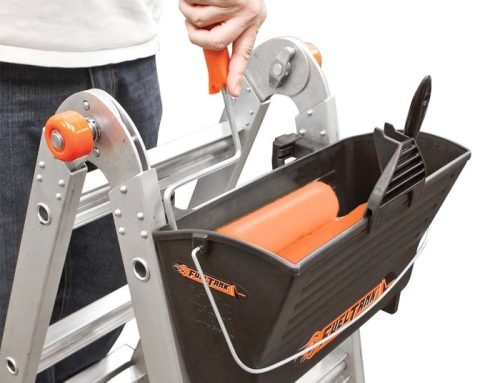A common myth about ladders is that they're banned on construction sites; this rumour started over a decade ago after the Health and Safety Executive recommended that alternative height access methods were considered for each job before a ladder was chosen. This was to ensure that if there were safer and more appropriate height access methods available, that they would be the first choice over simply opting for a ladder without considering the alternatives. Ladders are not banned, but those with a safety conscious approach would do well to consider other ways of completing the task.
This risk assessment approach is one that the home gardener ought to take. When we're working in our own gardens we're prone to taking risks because we feel a sense of safety from being in a familiar environment. We're also likely to continue with risk-taking behaviour if we've gotten away with it unscathed in the past, and this leads to easily avoidable accidents which often involve sharp tools for an added element of danger.
Pruning trees, overgrown shrubs or climbing plants is a job that often does require the use of a ladder, but this can be minimized by using a pole or telescopic pruner for parts of the job. It is best to carry out as much of the task as you can with one of these tools, saving the ladder for parts you can't reach, or areas where some more close attention is required. By spending 75% more of the task time on the ground you reduce your risk of a ladder fall by the same amount.
Hedge cutting and shaping is also a job where a ladder would traditionally be used. Many hedge cutters nowadays have a long handle to enable you to reach further from the safety of the ground, but very tall hedges where the top must be levelled out will require the use of a ladder.
When a ladder is needed for an outdoor job it is vital that you choose the right type of ladder. Tripod ladders are generally the best type to use for pruning jobs, as they're designed for use on soft ground. It seems odd that a ladder with fewer legs is more stable, but actually with fewer legs to sink into the ground, the ladder is safer and more stable on lawns and flower beds. The other advantage of a tripod ladder is that you are able to position the ladder much closer to the tree or hedge because of the “missing” leg not being in the way.
There are telescopic tripod ladders out there specifically designed to be used for hedge trimming. The telescopic legs allow for the angle of the ladder to be changed, and for uneven garden surfaces which would pose a problem for other types of ladder. Garden platforms, which are like a mobile scaffold, are perfect for topiary jobs, as well as sorting out unruly climbing plants, as they provide a wide working area. The wide platform means you can easily access a big section of the plant without having to move a ladder, and it's much easier and safer to wield tools when you're safely on a working platform rather than balancing at the top of a ladder.
It's the perfect time of year for these maintenance jobs before the new growth starts in spring, so when you're out in the garden, making a list of jobs, make sure you also have a list of height access equipment that you need for each task, as well as the tools that enable you to minimise the amount of time you need to spend up a ladder.






Leave A Comment
You must be logged in to post a comment.